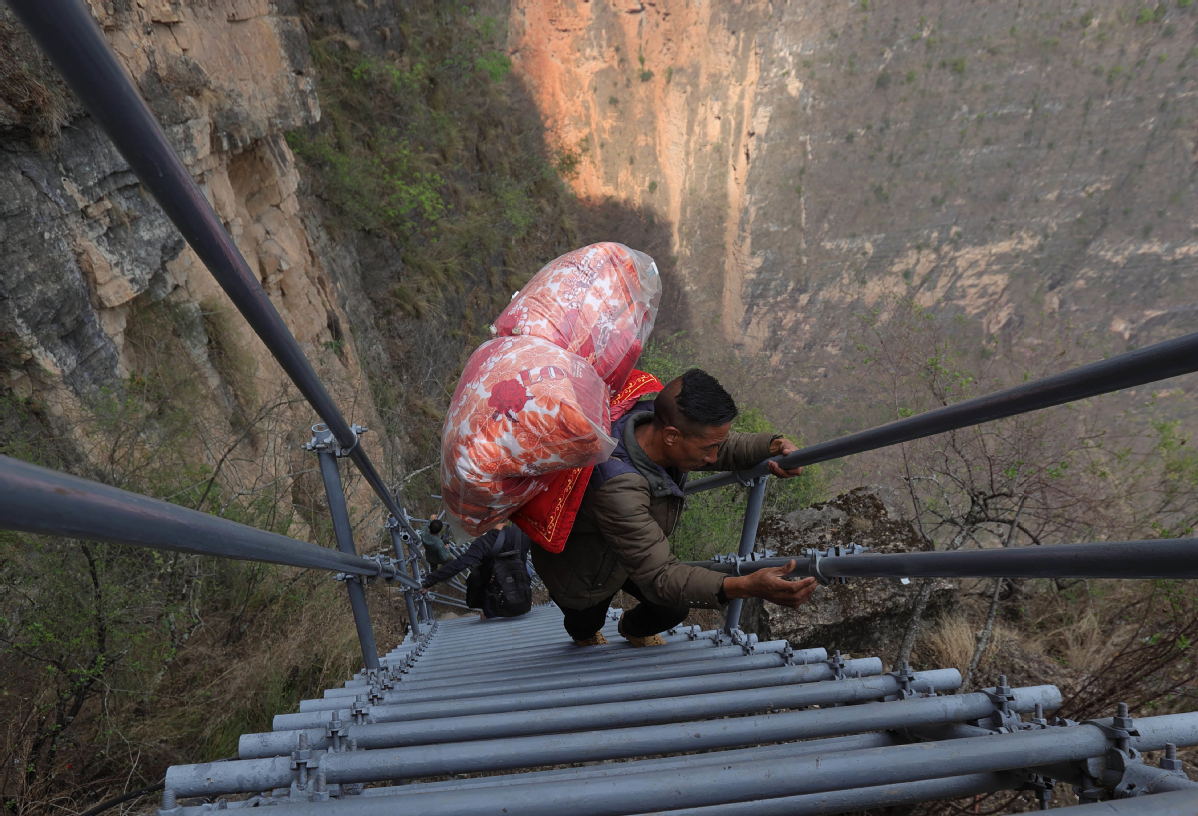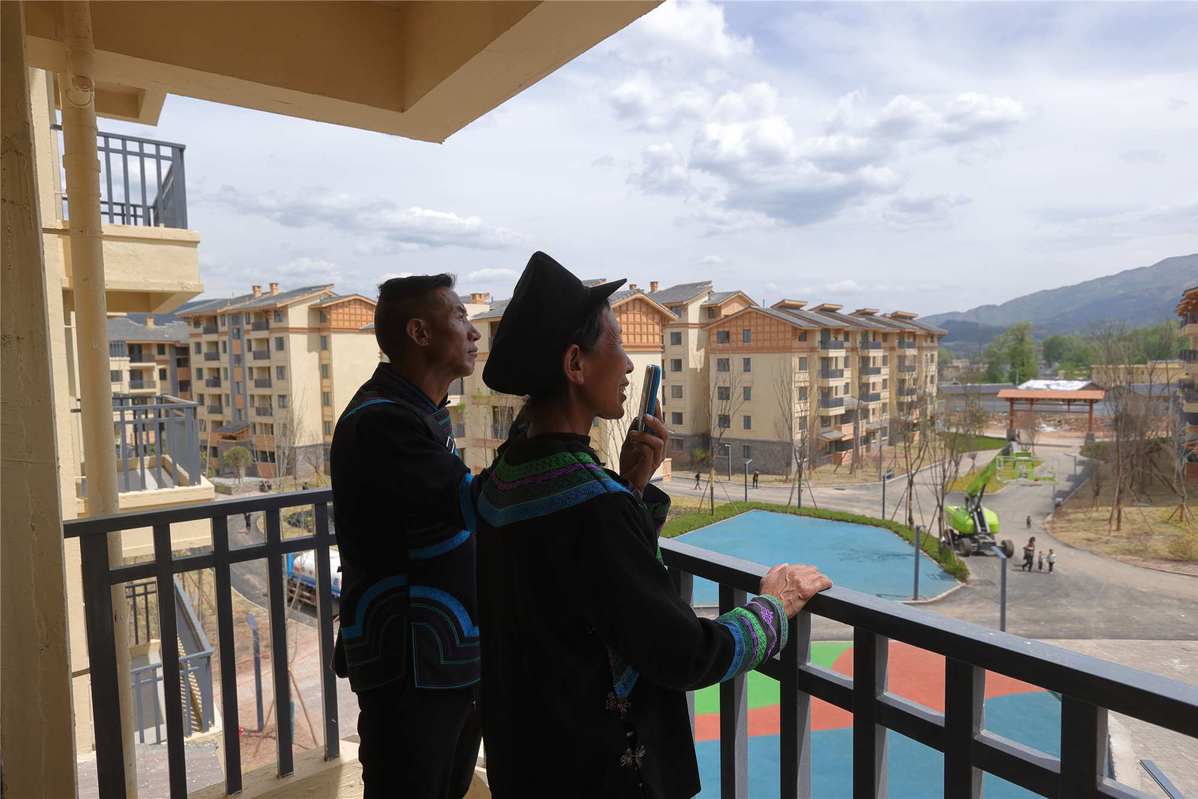Cliffside villagers step up to new homes and better lives
More than 80 households from Zhaojue county's Atuleer village had started moving to new apartments in the county seat earlier in May, as part of latest efforts in a nationwide poverty alleviation drive.
Yi ethnic group member Mose Ziha strums his guitar as he looks into his propped up mobile phone.
The 44-year-old then bursts into song, livestreaming in the Yi language a soothing folk melody about families warmly welcoming guests into traditional homes.
That is exactly what Mose is doing – only that his home is a gleaming unit in a month-old apartment complex, complete with running water, electricity and other modern amenities.
"It is very comfortable here and I'm enjoying facilities I never had. I have everything I need," Mose said of his apartment in Zhaojue county of the Liangshan Yi autonomous prefecture, Sichuan province.
He is one of more than 80 households from the county's Atuleer village that had started moving to new apartments in the county seat earlier in May, as part of latest efforts in a nationwide poverty alleviation drive.

Atuleer villager Mose Dati, 51, climbs down the metal ladder structure with his belongings to a new home in the county on May 13. [Photo/Xinhua]
Local government reports point to Zhaojue's significant achievements in poverty alleviation, in line with the nation's aim to eradicate extreme poverty — defined as living with less than 2,300 yuan (US$325) in annual income — by the end of this year.
By the end of last year, 136 of the 191 impoverished villages in Zhaojue were lifted out of poverty, with 67,932 poor people from 15,239 households lifted out of poverty and the poverty rate dropping from 31.8 percent to 11.3 percent.
As of mid-June, the remaining 55 impoverished villages in the county, covering 7,081 households with 33,073 poor people, all shed their poverty label. In Atuleer alone, per capital income of poverty-hit residents is forecast to rise above 9,000 yuan by this year, or nearly five times the 1,961 yuan per capita income of poor households identified in 2014.
Comprehensive measures to fight poverty range from housing and health to entrepreneurship and education. County plans include safe housing projects for more than 4,800 needy households, over 100,000 night-school classes for farmers, nearly 10,000 skills and entrepreneurship sessions, and extensive public health and environmental projects for rural families. Business enterprises and groups from more developed coastal areas also work with the agricultural sector and help build Zhaojue's industries.
Liao Yuchao, the deputy county head leading its anti-poverty push, said the approach is a multilevel, multipronged one rooted in the provision of basic infrastructure and services and the development of income channels that tap the county's geographical, economic advantages and other strengths.
"This is a targeted effort. We must ensure that our residents continue to contribute to the economy and be part of society," he said.
Tall order
Atuleer village, perched on a 1,400-meter-high cliff, drew widespread attention four years ago when a Chinese newspaper published photos of resident students going to classes by scaling a patchwork of mountainside rattan ladders stretching 800 meters. The treacherous trip was also the main way for villagers to get to the nearest market several kilometers away once a week to obtain basic necessities and sell crops such as Sichuan peppercorns and walnuts.
President Xi Jinping himself expressed concern about the villagers and their reliance on the rattan ladders during a discussion with National People's Congress deputies from Sichuan three years ago amid the annual two sessions in Beijing, after he came to know about the villagers' plight in a TV broadcast.
Xi said the whole process of poverty alleviation needed targeted policies and precise, detailed measures, similar to what went into making intricate embroidery.
To help the villagers, the county and prefectural government had directed 1 million yuan (US$141,000) to construct a handrailed, 2,556-stepped ladder made up of metal poles, making their climb safer and reducing their travel time to the nearest town by one-third to an hour.
Ake Jiushe, deputy head of the county's information department and author of a major book detailing the development of the village in recent years, said the improved climbing conditions have certainly been a step up for Atuleer's progress, with many tourists also heading to the area and contributing to the local economy.
The village is set to become an anchor point for local authorities' focus on developing rural tourism into a pillar industry, including a few households staying behind to offer food and lodging to visitors even as most villagers move out to better work and living conditions in Zhaojue.
"The improvements have been remarkable since Atuleer took the spotlight and we're looking ahead to the next steps in its development," Ake said.

A newly resettled couple in Zhaojue's Nanping apartment complex on May 13. [Photo/Xinhua]
Solid support
At the county seat, under government subsidy plans for the new apartments, each Atuleer villager pays about 3,000 yuan for 25 square meters, with the payment capped at 10,000 yuan for the largest 100-sq-m unit housing a family of four members or more. Each family also receives nearly 2,000 yuan to help purchase household items. The government support is significant considering housing prices in the county that can average about 4,000 yuan per square meter for similar property, residents said.
Villager Mose Ziha said the recent years' influx of tourists, who bought his walnuts, olive oil and other produce, helped to more than double his annual income to about 10,000 yuan. Just his walnut yield rose twofold to about 15 yuan a kilogram after riding on the increase in tourists.
Like other relocated Atuleer villagers, he maintains his small plot of land in the mountains even as he looks for work in urban areas to boost his income after moving from a cliffside adobe hut to his 50-sq-m one-bedroom apartment, which he shares with his brother. Mose Ziha livestreams songs and other performances for social media fans – many of them buy his crops – with at least 5,000 of them on major video-sharing site Douyin.
Api Lari, deputy Party secretary of the new Yiwu community housing more than 2,700 resettled villagers like Mose Ziha, said site amenities include a canteen, residents' cultural activities center, children's learning areas and even a retail strip offering traditional ethnic products and artwork like elaborate Yi embroidery to further supplement residents' incomes.
"They are not simply transitioning from adobe to concrete; these people are also getting support to develop their lifestyles and mindsets," Api said.
Mose Wuha, a resettled Atuleer villager in the nearby Nanping new housing area, moved to his new 100-sq-m, three-bedroom apartment at the top floor of a five-story block in mid-May. Mose Wuha's 19-year-old son, the eldest of his four children, lives with him while they wait for the rest of the family who will move from the cliffside village in the coming months.
Mose Wuha, 48, said he ran an unprecedented stall at the peak of Atuleer selling refreshments to tourists after they were drawn to the area when the handrailed metal ladder was set up. That helped him make up to 2,000 yuan a month, a substantial upgrade from the subsistence farming he previously practiced. He is planning to operate a shop in his new community to continue selling local items, including his own Atuleer crops.
"This is a great change for us. We can keep our links with Atuleer and access better social benefits in the county seat like healthcare," Mose Wuha said. "My children are already getting opportunities I never had. My youngest daughter, she is 7, can actually speak better Mandarin than me. She is enjoying school in Atuleer and we are all looking forward to living together again once the move is completed."
Learning advantage
The local school offering classes up to primary level at the foot of Atuleer is also being upgraded, with room and board facilities that can help accommodate 600 people on top of annual subsidies of 4,500 yuan for each student.
Gao Juan worked in retail but decided to teach at the school two years ago to do more for the community. The 30-year-old, who conducts Chinese and math classes, said the positive impact of the poverty alleviation measures on her students has been very heartening.
"Parents themselves also care more about the education of their children. Even in terms of better health and hygiene, the students help influence their family," she said.
Eleven-year-old student Jiba Zili said she enjoys her classes, which she used to take about three hours to reach from her home at the mountaintop before the metal ladder was built. That climb, reduced by an hour, is also more pleasant now, she said. Jiba said she is looking forward to the new communities in the county seat. "I also want to visit Beijing," she said.
On the slopes en route to Atuleer, Chimu Ashi, 54, sells village specialties to tourists trying out the climb and makes up to 300 yuan a day during peak travel to the increasingly popular scenic spot. Previously, she had to rely solely on farming to survive.
"I've been here since I was 5," she said. "This is a big improvement."

